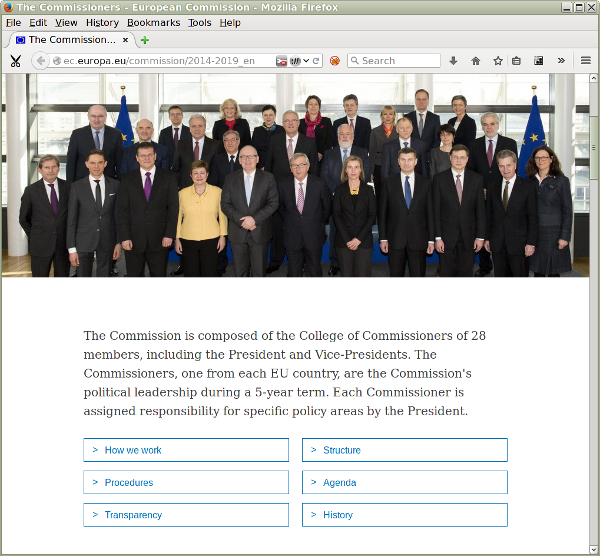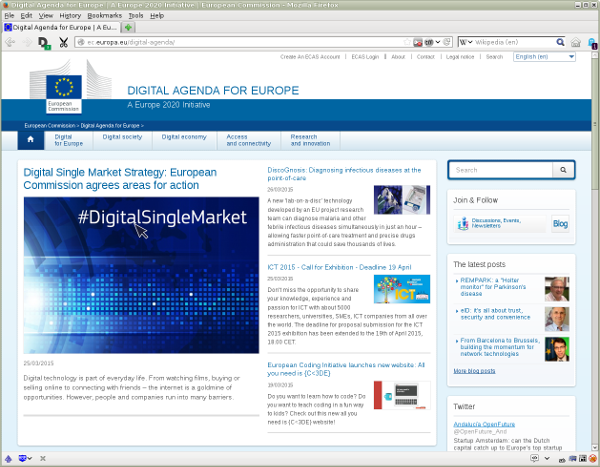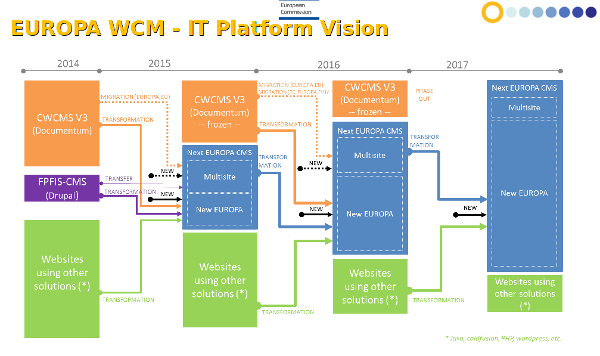Last summer, the Directorate General for Informatics (DIGIT), and DG Communication (DG COMM) started the implementation of the new europa.eu platform. This is built on Drupal version 7 and will replace the current Corporate Web Content Management System (CWCMS) based on Documentum, as well as the temporary Multisite Platform also based on Drupal 7. The Digital Transformation programme, which will consolidate all Europa websites onto the new platform, is led by DG COMM, DG Translation (DGT) and DIGIT, working in partnership with all DGs and executive agencies. From 2017, all new websites will be developed on the Europa platform.
Description of the way to implement the initiative
Last summer, DIGIT and DG COMM started the implementation of the new Europa platform. The aim is to provide the European Commission with the modern platform it needs make the most of new digital trends, and to help the organisation build a public web presence which is more relevant, coherent and cost-effective. The Digital Transformation programme, which is consolidating all Europa websites onto the new platform, is led by DG COMM, DGT and DIGIT, working in partnership with the DGs and executive agencies.
Two examples currently available on the new Europa platform are:
- the new College and Commissioners' website, and
- the EU Digital blog.

Technology solution
In 2013, DIGIT, in close collaboration with DG COMM, studied the requirements for a new europa.eu platform. They concluded that Drupal version 7 was suited to implementing the next Web Content Management System (WCMS). The new Europa platform would replace the current Corporate Web Content Management System (CWCMS) based on Documentum, as well as the temporary Multisite Platform also based on Drupal 7.
Multisite Platform
The Multisite Platform was started at the end of 2011 as an initiative to rationalise the web presence of the EC. Its aim was to cut down the number of Europa web pages and WCMSs in order to make the EC's online communication more coherent, relevant and cost-effective.
The objectives of this initiative were:
- synergies in shared services, a common web management infrastructure, and re-use of common components;
- a coherent corporate image, catering for mobile devices via a responsive web design and integrating social media functionality;
- cost sharing amongst the DGs.
The benefits of the Multisite Platform are:
- modern, interactive websites for citizens and stakeholders;
- decreased time to market for new and revamped websites;
- supporting webmasters and contributors in the maintenance of websites;
- reduced costs for the EC's web presence;
- use of free open source software tools;
- valuable input for the next Europa infrastructure and a simplified migration path towards this.
Drupal and LAMP
The Multisite Platform is based on Drupal version 7, an open source Content Management Framework (CMF, i.e. a system for building CMSs). The user interface is built using the popular front-end framework Bootstrap.
The platform is offered centrally by DIGIT as a Software-as-a-Service (SaaS) to other DGs and executive agencies. It is built on the open source LAMP stack: Linux, Apache, MySQL, and PHP. The Drupal/LAMP architecture allows multiple websites to be deployed on the same installation, or the other way around, to scale out using multiple webservers, load balancers and caching systems. The platform uses the Apache Solr search engine.
Specific functionality
The Multisite Platform offers all of the functionality that comes with Drupal as a standard component (the Core) and dozens of other components. Furthermore, it can be extended using the thousands of modules that are available for download from the central Drupal repository, as long as they fit the architecture defined by DIGIT. Every DG can use all of the existing platform features.
In addition to the publicly available Drupal components, various Commission services have developed specific functionality that has now become part of the Multisite Platform. According to Rosa Ordinana-Calabuig, the IT Project Manager at the EC responsible for the Multisite Platform, each DG finances its own specific features or global features if they do not yet exist within the platform. Most of the time, the new functionality can be built using existing Drupal modules, which are then adapted to the requirements of the EC.
Here are some examples of features developed specifically for the Multisite Platform:
- ECAS integration:
integrates with the EC Authentication System (ECAS), providing Single Sign-On (SSO) functionality; - CCK integration:
integrates the Cookie Consent Kit, making the platform "cookie law" compliant; - AV portal integration:
integrates the AV portal, allowing videos to be embedded in the content body; all videos can played using the AVS Media Player (Windows only); - Newsroom integration:
imports taxonomies and content from a central news repository and offers a flexible way to display these in context with other relevant content from the site; - Multilingual tools:
this module provides tools to enhance the translation tasks; - Multilingual references:
provides internal links from one piece of content to another, leading to content available in the reader's own language or, if no language setting is available, to a small popup giving a choice of translations; - Press releases:
provides aggregator functionality, allowing press releases from the EC's press room to be incorporated into the platform; - Social bar:
displays a bar with up to four social networks to emphasize and simplify social sharing; - machine translation:
integrates a machine translation system, automating the translation of content as it is published.
Currently, over 60 EC websites are using the Multisite Platform. Some examples are:
- http://ec.europa.eu/digital-agenda/
- http://europa.eu/youth/splash_en
- http://ec.europa.eu/energy/
- http://europa.eu/workingforyou/
- https://ec.europa.eu/programmes/horizon2020/

The Joinup portal is currently being migrated to Drupal 7 as well.
Consolidation
The Multisite Platform was intended to be a temporary solution from the beginning. Last January, the two Drupal platforms were integrated into a single stack. In addition to the underlying LAMP datacentre infrastructure, the two platforms now also share the Drupal 7 CMF and the first layer of customisations and features. The remaining customisations, features and theming will be migrated from the Multisite Platform to the new Europa platform over the next few years.
The integration of the two Drupal-based platforms leads to:
- better use of resources, with a single development team maintaining a single platform,
- re-use of Multisite features for the new Europa platform, accelerating the development of the latter, and
- better maintainability, standardisation and quality of the platform.
Further development on the old Documentum-based CWCMS will be frozen this year, and the platform will be phased out by 2017. New websites can be built on the Multisite Platform until the end of next year, although this is not recommended. Websites using other CMSs will be migrated to the new Europa platform. From 2017, all new websites will be developed on this platform.

Technology choice: Mainly (or only) open standards, Accessibility-compliant (minimum WAI AA), Open source software
Main results, benefits and impacts
Websites are a cost-effective, accessible and efficient means of communication. Currently, the Europa portal is composed of more than 460 websites. Most of these are static pages managed using either the Corporate Web Content Management System (CWCMS) based on Documentum, or plain HTML editors.
The CWCMS was the solution recommended until beginning of 2014, but this platform will be phased out by the end of 2016. Furthermore, the current Drupal 7 solution, the Multisite Platform, has just been merged into the new Europa platform, also based on Drupal 7. From 2017, all new websites will be developed on this platform. This common approach to dynamic website management will mitigate the plethora of technical tools employed at the EC, decreasing the cost of their maintenance and infrastructure.
Benefits of this Drupal 7 platform consolidation are:
- better use of resources, with a single development team;
- total re-use of Multisite Platform features for the new Europa platform;
- shorter time to market for new sites and sections;
- avoidance of technological fragmentation;
- infrastructure resources efficiency;
- reduced costs exploiting economies of scale;
- cloud readiness;
- improvement of maintainability, standardisation and quality of the platform.
According to Ordinana-Calabuig, the new Europa platform is a great opportunity for the Commission to achieve more productive and efficient content management and publication on its websites by measuring up to the highest technical standards. The centrepiece of the platform is the new framework based on Drupal. It will help the Commission to deliver a better user experience, particularly with regard to social media, mobile responsiveness and multilingualism.
Lessons learnt
Scope: European

